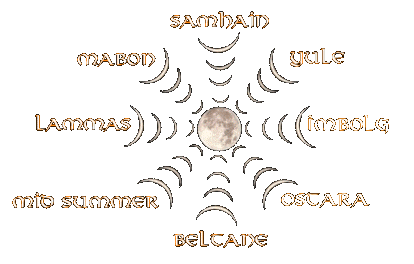
Most Wiccans celebrate eight holidays throughout the year, each marking a specific time in the season. Sabbats are ceremonies which are performed in order to honor a god/goddess/season. Often there is a feast and festivities at the Sabbat. In the wheel of the year, there are four major Sabbats and four lesser Sabbats. The major Sabbats include Samhain, Imbolc, Beltane, and Lammas. Yule, Ostara, Litha, and Mabon make up the four lesser Sabbats. Samhain
Samhain (pronounced Sow-een or Sow-in) is celebrated on October 31st ( May 1st in the Southern Hemisphere). This is the "Witches New Year" and the primary Sabbat from which all others flow. It is said that on this night, the veil between the two worlds is thinnest. Also it represents the time where the God dies and the "dark" age prevails. The Goddess awaits the return of the God (Yule) from here on out. It also represents the celebration of continued life. Traditionally, four Jack 'O Lanterns are carved and one placed at each elements' quarter. This is done to frighten unwelcome spirits away faces , but the glow from inside the pumpkin will let the welcomed spirits know where to go. The alter can be decorated with fall leaves, pumpkins, corn, gourds, and anything else related to the season. This is the third harvest festival.
Imbolc
Imbolc (pronounced em-bowl/g or em-vole-g) is celebrated on February 2nd (around August 2nd in the Southern Hemisphere). This day represents the first day of the wiccan spring and is sometimes called Candlemas or The Festival of Light. On this night, many candles are lit to represent the awakening of the Earth. To speed up the spring season, place a bowl of melted snow on the alter.
Beltane
Beltane (pronounced beel-teen or bell-tawn) is celebrated April 30th or May 1st (on October 31st or November 1st in the Southern Hemisphere). This is the celebration of rebirth, life, and love. One familiar tradition of Beltane is the Maypole. The ribbons on the pole are white and red to represent the Goddess and the God. There is love between the God and the Goddess as well as in our hearts on this day. This is also the time for new beginnings and projects.
Lammas
Lammas (pronounced Lam-mahs) is celebrated on August 1st (on February 1st in the Southern Hemisphere). This is a celebration to honor the Celtic Sun God, Lugh. It also gives thanks to Spirit for the abundance if the Earth because this is the first of the harvest festivals. Food is placed on the alter as an offering and the entire day is one for picnicking and games. Lammas is also known as the Wiccan Thanksgiving.
Yule
Yule is usually celebrated on December 21st or 22nd (on the 21st or 22nd of June in the Southern Hemisphere). On this day, wiccans celebrate the rebirth of the God and his gifts of warmth and fertility. Candles are traditionally lit and left burning all night on the alter and a Yule Tree (or sometimes called "wish tree") is decorated. On this night, it is said, that the Oak King (of the waxing or first half of the year) fights and suppresses the Holly King (of the waning or second half of the year). Wiccans see the Holly King as "Father Christmas", wearing a red robe and holly atop his head. He drives his sleigh of eight (the number of Sabbats) deer (a symbol of the horned God) through the night. Also, wreathes are hung to represent the wheel of the year.
Ostara
Ostara (pronounced Oh-star-ah) is usually celebrated on March 21st or 22nd (on the 21st or 22nd of September in the Southern Hemisphere) It is sometimes called Lady Day, and it represents the return of fertility to the land. One well known tradition is coloring/dying and decorating eggs.
Litha
Litha is usually celebrated around June 21st or 22nd(on December 21st or 22nd in the Southern Hemisphere). This day represents the strength of the God for he has reached his peak. The Oak King and the Holly King come to fight again on this day, however, this battle is won by the Holly King. Herbs are also harvested and a bale fire is lit.






